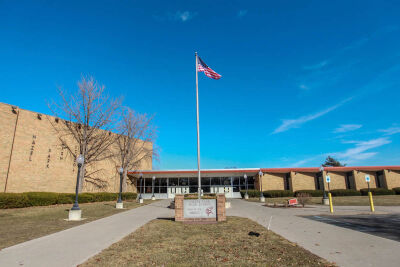
A $150 million school improvement bond proposal failed in the Hazel Park Public Schools district on May 7.
File photo by Patricia O'BlenesWL
HAZEL PARK — During the special election on May 7, residents in the Hazel Park Public Schools district showed overwhelming opposition to a proposed $150 million school improvement bond that would have been paid over the next 30 years.
Out of 2,203 votes cast, 66% said no (1,462 votes).
“I think it’s pretty disappointing, but the democratic process is in place, and we lost two to one,” Hazel Park Public Schools Superintendent Amy Kruppe said the morning after the election. “I think over the next several months, the board members will have to come back and decide the next steps, because our infrastructure issues are still present. There are critical safety needs and crumbling buildings here, 50-70 years old, which will have to be addressed. This bond would have been about investing in our children’s futures, and keeping our students safe, warm and dry.”
Rachel Noth, a former member of the Hazel Park Public Schools Board of Education (2015-22), was part of a group called With Students in Mind, which opposed the bond. She said her group is open to bonds, but that members felt this proposal was poorly communicated, asking a lot of taxpayers without their feedback.
“I’m deeply humbled, and so proud of my community for its attentiveness to handling this issue and making the best decision,” Noth said the morning after the election. “While I can understand (Kruppe’s) concern about the buildings, I think this will allow us to properly plan and have all facets of the community around the table, and to put together a more fiscally responsible bond proposal that everyone in the community can afford.”
Officials said that had the bond been approved, taxpayers would have seen no increase in the school tax rate, since the bond would have extended the current millage for the entirety of the proposal for a zero-mill net increase.
The estimated levy this year would’ve been 5.65 mills, which is $5.65 on each $1,000 of taxable valuation. The estimated simple average millage to retire the bond debt was expected to be 9.42 mills. Officials also said that the total millage rate would have declined in time.
By law, none of the funds could have been used for employee salaries. The funds also could not be used for maintenance costs or operating expenses.
The bond would have funded the construction of a new elementary school (71,000 square feet) to replace Webster Early Childhood Center, located at 431 W. Jarvis Ave. The new construction was deemed more cost effective than renovations. The elementary school would have been designed with input from residents. As for the early childhood services at Webster, they would have been relocated to Hoover Elementary.
The bond also would have paid for upgrades at nine other sites, including Hoover Elementary, Webb Elementary, United Oaks Elementary, Jardon Vocational School, Hazel Park Junior High, Hazel Park High, INVEST Roosevelt Alternative High, the Ford Advantage Alternative School and Administration Building, and Camp Hazelwood.
New safety and security features would have been implemented districtwide, including the construction or remodeling of secure entrances, new exterior and interior doors with door locks, and new systems for public announcements. There also would have been learning space improvements, including upgrades to lighting, carpeting, furniture, ceilings and restrooms in select classrooms, and a renovated auditorium at the high school featuring a new sound booth, lighting, and upgrades to audio and video systems. The high school also would have received a new emergency generator.
In addition, heating and cooling systems would have been upgraded across the district, including the replacement of boilers at select schools. Roofs and windows would have been replaced where needed. There were also plans to replace the turf, track, bleachers, scoreboard and press box at the high school. Outdoor learning spaces were also planned at select sites.
As for Camp Hazelwood, the plan was to update the restrooms, showers, bunkhouses, lighting, community spaces and outdoor learning spaces. This would have included accessibility improvements made in compliance with the Americans with Disabilities Act.
The proposal was the result of an internal review in 2023, where school administration worked with architectural and construction management specialists to assess the condition of district facilities. Together, they assembled a project list totaling more than $300 million, which was then cut in half to avoid a millage increase, focusing only on priority needs.
Noth said many residents told her the process felt rushed.
“People feel a bit overextended right now with inflation and such. I think if we could vet the process with committees and community input over a longer time frame, we would better understand how much we actually need to spend right now, and not overextend our credit line. Maybe instead of 30 years, we could look at a five- or seven-year commitment, and pay that off first. We also have concerns about declining enrollment, and about improving our test scores,” Noth said. “We just need to be sure we’re smart about this. We want to have everyone’s input, and make sure everyone feels OK paying an extra 50 cents or a dollar, or whatever.”
Kruppe said the bond would’ve been a good investment.
“I understand it’s a very difficult time, tax-wise, but this would not have increased the tax rate that residents currently pay, and in fact, their taxes would’ve gone down over time,” Kruppe said. “Ultimately, it’s my belief that good schools make good communities.”
 Publication select ▼
Publication select ▼



















